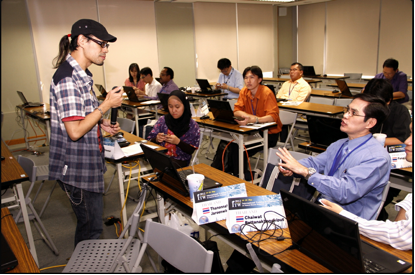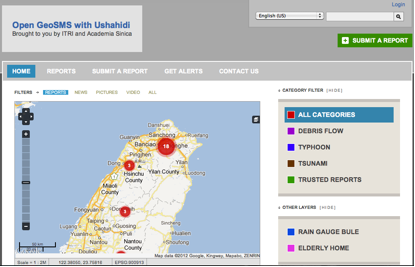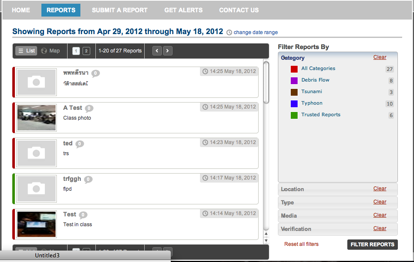[Guest blog post by Kuo-Yu slayer Chuang from Tawain's Industrial Technology Research Institute, ITRI.]
 Ushahidi 2.0 with its featured plug-in architecture could make the platform extended with other functions and meet different needs.
In our previous article, we briefly introduced the concept of Open GeoSMS and mentioned the future works of implementation of Open GeoSMS plug-in for Ushahidi. After long await and our collaboration with Ushahidi development team, we are proud to announce that OpenGeoSMS plug-in is now available on the Ushahidi platform.
Ushahidi 2.0 with its featured plug-in architecture could make the platform extended with other functions and meet different needs.
In our previous article, we briefly introduced the concept of Open GeoSMS and mentioned the future works of implementation of Open GeoSMS plug-in for Ushahidi. After long await and our collaboration with Ushahidi development team, we are proud to announce that OpenGeoSMS plug-in is now available on the Ushahidi platform.

 This Open GeoSMS plug-in enhances the automation for incident report and leverage the advantage of smart phones even they couldn’t connect to Internet. For the International Standby Task Force for disaster responses, we believe that they have better chance to have smart mobile device and can do the reliable reports. It’s quite expensive to enable roaming data plan, but SMS feature will be ready for use with less concerns. That’s also one of the major reasons for us to provide Open GeoSMS features on both Ushahidi server and app. Of course, source code was up-streamed and can be found on the Ushahidi community page.
We have also demonstrated and done a simulation with the participants of 2012 International Training Workshop for Natural Disaster Reduction in Taipei. With 18 Disaster Management practitioners from Indonesia, India, Panama, Taiwan, Thailand, and the Philippines, we demonstrated how reporters use their smart phones to send out an Open GeoSMS, and the projected screen shows right away the incident map and reports. The outcome turned out very successful and the participants were excited to use the application during deployments.
We are GeoThings, any comments or interest on Open GeoSMS, please visit our Facebook page or the GeoThings blog, would love to hear from you.
This Open GeoSMS plug-in enhances the automation for incident report and leverage the advantage of smart phones even they couldn’t connect to Internet. For the International Standby Task Force for disaster responses, we believe that they have better chance to have smart mobile device and can do the reliable reports. It’s quite expensive to enable roaming data plan, but SMS feature will be ready for use with less concerns. That’s also one of the major reasons for us to provide Open GeoSMS features on both Ushahidi server and app. Of course, source code was up-streamed and can be found on the Ushahidi community page.
We have also demonstrated and done a simulation with the participants of 2012 International Training Workshop for Natural Disaster Reduction in Taipei. With 18 Disaster Management practitioners from Indonesia, India, Panama, Taiwan, Thailand, and the Philippines, we demonstrated how reporters use their smart phones to send out an Open GeoSMS, and the projected screen shows right away the incident map and reports. The outcome turned out very successful and the participants were excited to use the application during deployments.
We are GeoThings, any comments or interest on Open GeoSMS, please visit our Facebook page or the GeoThings blog, would love to hear from you.
 Ushahidi 2.0 with its featured plug-in architecture could make the platform extended with other functions and meet different needs.
In our previous article, we briefly introduced the concept of Open GeoSMS and mentioned the future works of implementation of Open GeoSMS plug-in for Ushahidi. After long await and our collaboration with Ushahidi development team, we are proud to announce that OpenGeoSMS plug-in is now available on the Ushahidi platform.
Ushahidi 2.0 with its featured plug-in architecture could make the platform extended with other functions and meet different needs.
In our previous article, we briefly introduced the concept of Open GeoSMS and mentioned the future works of implementation of Open GeoSMS plug-in for Ushahidi. After long await and our collaboration with Ushahidi development team, we are proud to announce that OpenGeoSMS plug-in is now available on the Ushahidi platform.

Here’s how things work:
On the reporting side, a smart phone user could do incident report on official Ushahidi app via Internet or SMS, which is geo-tagged Open GeoSMS. The administrator of Ushahidi Server can enable Open GeoSMS plug-in to parse the in-coming SMS for knowing if it’s a regular SMS or a geo-tagged Open GeoSMS. Our Open GeoSMS plug-in also works with SMSSync and FrontlineSMS plug-in, you may enable those two plug-ins for receiving SMS from your mobile phone, sync with specified Ushahidi server, and those geo-tagged Open GeoSMS will be pinned down with its location on map. This Open GeoSMS plug-in enhances the automation for incident report and leverage the advantage of smart phones even they couldn’t connect to Internet. For the International Standby Task Force for disaster responses, we believe that they have better chance to have smart mobile device and can do the reliable reports. It’s quite expensive to enable roaming data plan, but SMS feature will be ready for use with less concerns. That’s also one of the major reasons for us to provide Open GeoSMS features on both Ushahidi server and app. Of course, source code was up-streamed and can be found on the Ushahidi community page.
We have also demonstrated and done a simulation with the participants of 2012 International Training Workshop for Natural Disaster Reduction in Taipei. With 18 Disaster Management practitioners from Indonesia, India, Panama, Taiwan, Thailand, and the Philippines, we demonstrated how reporters use their smart phones to send out an Open GeoSMS, and the projected screen shows right away the incident map and reports. The outcome turned out very successful and the participants were excited to use the application during deployments.
We are GeoThings, any comments or interest on Open GeoSMS, please visit our Facebook page or the GeoThings blog, would love to hear from you.
This Open GeoSMS plug-in enhances the automation for incident report and leverage the advantage of smart phones even they couldn’t connect to Internet. For the International Standby Task Force for disaster responses, we believe that they have better chance to have smart mobile device and can do the reliable reports. It’s quite expensive to enable roaming data plan, but SMS feature will be ready for use with less concerns. That’s also one of the major reasons for us to provide Open GeoSMS features on both Ushahidi server and app. Of course, source code was up-streamed and can be found on the Ushahidi community page.
We have also demonstrated and done a simulation with the participants of 2012 International Training Workshop for Natural Disaster Reduction in Taipei. With 18 Disaster Management practitioners from Indonesia, India, Panama, Taiwan, Thailand, and the Philippines, we demonstrated how reporters use their smart phones to send out an Open GeoSMS, and the projected screen shows right away the incident map and reports. The outcome turned out very successful and the participants were excited to use the application during deployments.
We are GeoThings, any comments or interest on Open GeoSMS, please visit our Facebook page or the GeoThings blog, would love to hear from you.